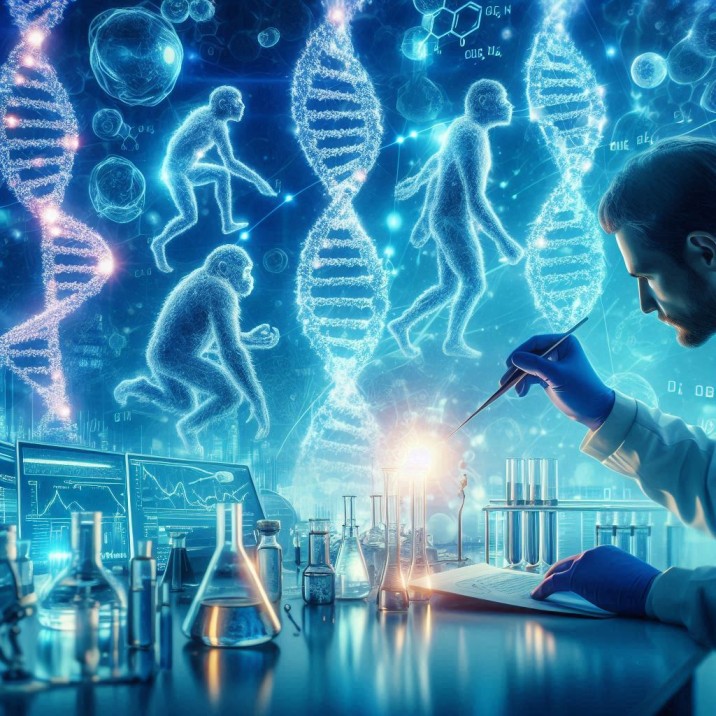Introduction
Evolution Class 12 Biology is a crucial topic that explains how life on Earth has changed over time through genetic variations and natural selection.
The diversity of life that exists today is the result of creatures gradually changing over many generations, a process known as evolution.
It explains the origins, adaptations, and differences between species, making it a major theme in biology.
This research sheds light on genetic variety, natural selection, and the long-term evolution of species.

Origin of Life
Theories Regarding the Origin of Life A number of hypotheses try to explain the genesis of life
Theory of Special Creation: A divine force created life
The Panspermia Hypothesis states that life originated in space as microbes or spores
Haldane-Oparin Hypothesis: Complex organic molecules were created by chemical processes in the early Earth’s atmosphere, giving rise to life.
The Miller-Urey Test
Stanley Miller and Harold Urey supported the Oparin-Haldane theory that life may arise from inanimate organic molecules by creating amino acids and simulating early Earth conditions in a lab.

Evolutionary Theories
Lamarck’s Evolutionary Theory According to Jean-Baptiste Lamarck, organisms evolve by gaining features throughout their lives and passing them on to their progeny.
This theory was later shown to be false, though.
Darwin’s Natural Selection Theory:
According to Charles Darwin, slow evolutionary changes occur when individuals with advantageous features survive and procreate while those with unfavourable traits die.
Neo-Darwinism
This contemporary theory of evolution emphasises the relevance of genetic variants and mutations in evolution by fusing genetics and Darwin’s theory.
Evidences for Evolution
Anatomical and Morphological Proofs
Common ancestry is suggested by homologous structures, such as vertebrates’ forelimbs.
Convergent evolution
is the cause of similar structures, such as the wings of insects and birds.
Evidence from Embryology Evolutionary links can be inferred from similarities in embryonic development between species
Evidence from Palaeontology Historical records of extinct species and intermediate types can be found in fossils.
Genetic and Molecular Proof Similarities in DNA and proteins point to a shared ancestor amongst species.

Mechanism of Evolution
Change Variations in species are caused by abrupt genetic changes
Drift of Genetics Evolution is influenced by random variations in gene frequency, particularly in small populations
Flow of Genes Genetic diversity is brought about by the migration-induced transfer of genes between populations.
Natural Selection Advantageous characteristics help an organism survive and pass on its genes to the following generation
Hardy-Weinberg Principle
According to this theory, unless evolutionary factors influence a population, allele frequencies stay fixed.
Elements That Impact Genetic Equilibrium Changes Drift of Genetics Flow of Genes Natural Selection Non-Random Mating
Types of Evolution
Evolutionary Convergence Sharks and dolphins are examples of unrelated species that exhibit comparable characteristics as a result of similar environmental stresses.
Differential Evolution Darwin’s finches are one example of how a single species can evolve into several different species.
Evolution in Parallel Related species in similar settings undergo similar evolutionary changes.
Co-Evolution Pollinators and flowers are two examples of how two species change in reaction to one another.
Adaptive Radiation
when one species transforms into another in order to fill distinct ecological niches. For instance, depending on their food, Darwin’s finches developed a variety of beak shapes.
Speciation
how new species come into being.
Speciation Types Geographic isolation is the cause of allopatric speciation.
Geographical isolation is not necessary for sympatric speciation, which is frequently brought on by behavioural or genetic alterations.
Evolution and Human Welfare
Resistance’s Evolution Antibiotic-resistant bacteria develop.
Pesticide resistance develops in pests.
The Evolution of Illnesses Over time, some diseases change to become more or less virulent, which has an impact on treatment approaches.
Human Evolution
Early Human Migration and Origin Originating in Africa, humans progressively spread throughout the world.
Evidence of Human Evolution from Fossils Homo erectus > Homo sapiens → Homo habilis → Australopithecus.
Molecular Proof for the Evolution of Humans Humans and primates share tight genetic ties, according to DNA study.
Evolution of Life Forms: A Timeline
Before the Cambrian Period Earth’s formation and the emergence of basic living forms like bacteria.
Paleozoic Period: Fish, amphibians, and early reptiles’ evolutionary histories.
The Mesozoic Era: dinosaur era, when birds and animals first appeared.
The Cenozoic Era: The evolution of contemporary humans, primates, and animals
Extinction and Evolution
Mass Extinction Causes Changes in the climate Impacts of asteroids eruptions of volcanoes
Extinction’s Effect on Evolution: Mass extinctions provide new species the chance to develop and take control of ecosystems.
Evolution and Classification
How Classification Is Affected by Evolution Instead of merely using physical similarities to classify organisms, evolutionary relationships are used.
The Phylogenetic Tree An illustration of the evolutionary links between species
Modern Trends in Evolutionary Biology
Biotechnology’s Function in Evolution Cloning and genetic engineering have completely changed how we think about evolution.
Prospects for Evolutionary Research in the Future The genetic underpinnings of evolution and its effects on biodiversity are still being investigated.

Summary and Conclusion
Natural selection, genetic mutations, and environmental changes all contribute to the diversity of life, which evolution explains.
Knowledge of evolution is beneficial in disciplines like conservation, agriculture, and medicine.
If you want to dive deeper into Evolution Class 12 Biology and prepare effectively for NEET, check out our BioNotes for detailed explanations, diagrams, and quick revision tips. Our expert-crafted notes cover all key concepts, making your exam preparation easier and more efficient.👉 Get your BioNotes now from our Shop Page!
Frequently Asked Questions (FAQs)
What is the best evidence of evolution?
Fossil records and genetic similarities provide strong evidence for evolution
How does evolution affect biodiversity?
Evolution increases biodiversity by producing new species and genetic variations.
What is the difference between microevolution and macroevolution?
Microevolution – Small changes within a species (e.g., antibiotic resistance in bacteria).
Macroevolution – Large-scale changes leading to new species.
How do fossils provide evidence for evolution?
Fossils show transitional forms and evolutionary changes over time.
Can evolution be observed in real-time?
Yes, examples include antibiotic resistance in bacteria and changes in finch beak sizes.
